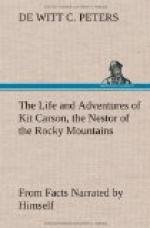made to the U.S. Government. It would be
superfluous, therefore, for us to fill up the pages
of the life of Kit Carson with matter already published
beyond the occurrences appertaining to him. Having
finished the observations upon Tlamath Lake, the expedition
started for California. The route led through
a barren and desolate country, rendering game scarce.
As the command drew near to the Sierra Nevada Mountains,
they were found to be entirely covered with deep snow
throughout the entire range of vision. At this
time the provisions had commenced giving out.
Game was so scarce that it could not be depended on.
The propositions which presented themselves at this
crisis were to cross the mountains or take the fearful
chance of starving to death. Crossing the mountains,
terrible though the alternative, was the choice of
all. It was better than inactivity and certain
death. On arriving at the mountains the snow
was found to be about six feet deep on a level.
The first task was to manufacture snow-shoes for the
entire party. By the aid of these foot appendages,
an advance party was sent on to explore the route
and to determine how far a path would have to be broken
for the animals. This party reached a spot from
whence they could see their way clear and found that
the path for the animals would be three leagues in
length. The advance party also saw, in the distance,
the green valley of the Sacramento and the coast range
of mountains. Kit Carson was the first man to
recognize these, to the snow-bound travelers, desirable
localities, although it was now seventeen years since
he had last gazed upon them. The advance party
then returned to their friends in the rear and reported
their proceedings. All were delighted on learning
that they had one man among them who knew where they
were. The business of making the road was very
laborious. The snow had to be beaten compact
with mallets. It was fifteen days before the
party succeeded in reaching, with a few of their animals,
a place where the heavy work of the route was ended.
During this time, many of their mules had starved
to death, and the few remaining were driven to such
an extreme by want of food, that they devoured one
another’s tails, the leather on the pack saddles;
and, in fact, they would try to eat everything they
could get into their mouths. The sufferings of
the men had been as severe as had ever fallen to the
lot of any mountaineer present. Their provisions
were all used and they were driven to subsist upon
the mules as they died from hunger. But, commander
and all bore these terrible trials in an exemplary
manner.




